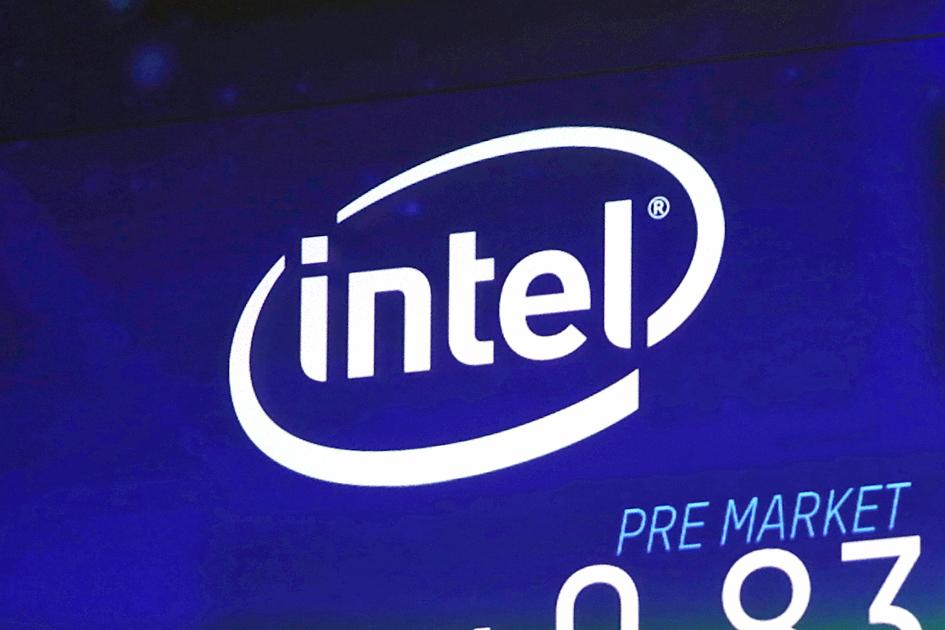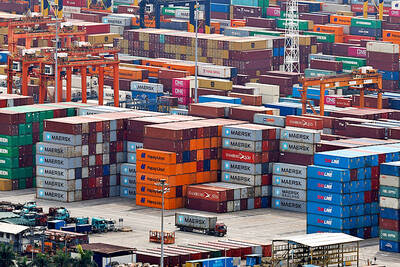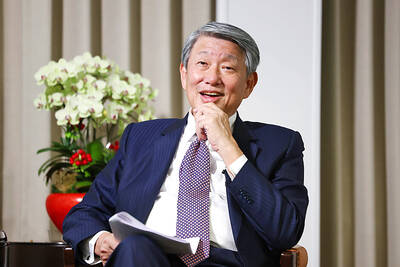Intel Corp agreed to sell its NAND memory unit to South Korea’s SK Hynix Inc for about US$9 billion, a deal that allows the US chipmaker to concentrate on its main business while shoring up the Asian company’s position in a booming market.
The chipmaker is to pay 10.3 trillion won (US$9.04 billion) for the Intel unit, which makes flash memory components for computers and other devices.
The acquisition, which is to take place in stages through 2025, includes Intel’s solid-state drive, NAND flash and wafer businesses, as well as a production facility in the northeastern Chinese city of Dalian.

Photo: AP
The deal should shore up Hynix’s position in a business that has boomed after COVID-19 drove demand for the chips used in everything from Apple Inc’s iPhones to data centers.
It whittles down another player in an industry the South Korean company dominates alongside Samsung Electronics Co and Micron Technology Inc, potentially buoying NAND flash memory prices.
Hynix’s shares fell about 1.8 percent after analysts raised concerns about the price tag on its largest acquisition ever.
“Hynix is now entering the hyperscale control chip business by purchasing Intel’s business. Although there is some skepticism about the price of the deal, I think this won’t be a burden because it will ensure solid long-term cash flow,” HMC Investment Securities Co analyst Greg Roh said. “The market consolidation is good news for [South] Korean memory chipmakers, and will alleviate oversupply issues.”
Intel has said for months that it was exploring options for the flash group.
However, Hynix would not be buying the Optane division, which develops chips that can permanently store data and read and write them faster than NAND — if not faster than traditional DRAM.
The product, which went on sale in 2018, was tested successfully by some large cloud providers and Alibaba Group Holding Ltd (阿里巴巴) used the technology to support its massive Singles’ Day sales.
Intel chief executive officer Bob Swan last year described Optane as “something special.”
Hynix said it would pay Intel US$7 billion before the end of next year, and the rest by March 2025.
Citigroup Inc advised Hynix, while Bank of America Corp did the same for Intel.
The deal could allow Hynix to surpass Kioxia Holdings Corp — a Toshiba Corp spinoff — in the NAND flash market, in particular, Bloomberg Intelligence analyst Anthea Lai said.
The deal would help the South Korean chipmaker surpass its second-biggest rival, Kioxia, by NAND flash revenue, Bloomberg Intelligence analysts said.
It would consolidate the NAND market, with Samsung, Hynix and Kioxia commanding more than 70 percent of revenue share, aiding NAND price recovery and narrowing losses, they said.
The deal also further streamlines Intel’s struggling empire.
Since taking over last year, Swan has looked to sell several units that are not part of the company’s focus on processors for personal computers and servers.
The Santa Clara, California-based company has delayed production of important upcoming chip lines and lags behind some industry players in manufacturing technology.
Its shares are down about 9 percent so far this year, while the benchmark Philadelphia Semiconductor Index is up almost 29 percent.
Despite the delays, the company’s server group has been performing well.
Shedding another non-core business could help Intel focus on fixing its chip technology woes.
Intel last year unloaded its smartphone cellular modem group to Apple and this year sold its home connectivity chips group to MaxLinear Inc.
In July, the company said it was considering moving away from manufacturing its own chips, potentially benefiting contract producers such as Taiwan Semiconductor Manufacturing Co (台積電) and Samsung.

The Eurovision Song Contest has seen a surge in punter interest at the bookmakers, becoming a major betting event, experts said ahead of last night’s giant glamfest in Basel. “Eurovision has quietly become one of the biggest betting events of the year,” said Tomi Huttunen, senior manager of the Online Computer Finland (OCS) betting and casino platform. Betting sites have long been used to gauge which way voters might be leaning ahead of the world’s biggest televised live music event. However, bookmakers highlight a huge increase in engagement in recent years — and this year in particular. “We’ve already passed 2023’s total activity and

Nvidia Corp CEO Jensen Huang (黃仁勳) today announced that his company has selected "Beitou Shilin" in Taipei for its new Taiwan office, called Nvidia Constellation, putting an end to months of speculation. Industry sources have said that the tech giant has been eyeing the Beitou Shilin Science Park as the site of its new overseas headquarters, and speculated that the new headquarters would be built on two plots of land designated as "T17" and "T18," which span 3.89 hectares in the park. "I think it's time for us to reveal one of the largest products we've ever built," Huang said near the

China yesterday announced anti-dumping duties as high as 74.9 percent on imports of polyoxymethylene (POM) copolymers, a type of engineering plastic, from Taiwan, the US, the EU and Japan. The Chinese Ministry of Commerce’s findings conclude a probe launched in May last year, shortly after the US sharply increased tariffs on Chinese electric vehicles, computer chips and other imports. POM copolymers can partially replace metals such as copper and zinc, and have various applications, including in auto parts, electronics and medical equipment, the Chinese ministry has said. In January, it said initial investigations had determined that dumping was taking place, and implemented preliminary

CUSTOMERS’ BURDEN: TSMC already has operations in the US and is a foundry, so any tariff increase would mostly affect US customers, not the company, the minister said Taiwanese manufacturers are “not afraid” of US tariffs, but are concerned about being affected more heavily than regional economic competitors Japan and South Korea, Minister of Economic Affairs J.W. Kuo (郭智輝) said. “Taiwan has many advantages that other countries do not have, the most notable of which is its semiconductor ecosystem,” Kuo said. The US “must rely on Taiwan” to boost its microchip manufacturing capacities, Kuo said in an interview ahead of his one-year anniversary in office tomorrow. Taiwan has submitted a position paper under Section 232 of the US Trade Expansion Act to explain the “complementary relationship” between Taiwan and the US